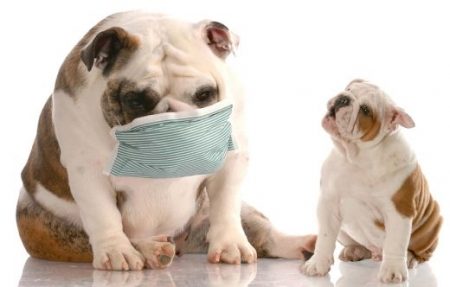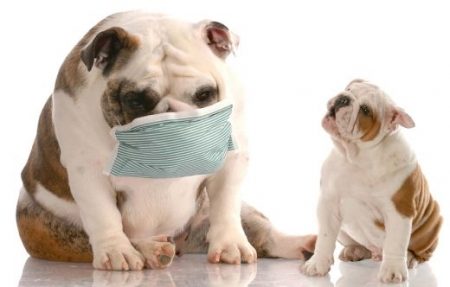

Canine Influenza: all seasons are flu seasons for dogs
You might read the title and think, but it’s the end of flu season. Isn’t this news a bit late? Winter is the notorious flu season for humans, but for our furry friends, canine influenza is not a seasonal, but year round health issue. We recently had a scare at my dog camp.
Quite unfortunately, a doggy packed and brought along a very unwelcomed guest; canine influenza – H3N8. This sent us into quarantine mode and racing to best contain the spread, treat anyone that became symptomatic and educate pet parents on the possible exposure. It was our first exposure to a respiratory virus and let’s hope our last (I enjoy setting unrealistic goals).
Some may scratch their head and say, "I can’t believe she is admitting the flu came through her doors." Pet parents need to understand that canine influenza is not the fault of daycares, grooming salons, dog training centers, veterinary offices, pet supply stores, boarding facilities and kennels. How the business reacts to the flu is important; but keeping a social canine environment completely free of viruses is as easy as it is to keep a school or office free of viruses. Pesky viruses are a part of human and canine socializing. In leading a healthy, normal life, at times, your dog (and you) will be at risk of catching a virus.
Here’s the 411 on Canine Influenza:
Canine flu is new. It mutated in 2004 from equine influenza and first started popping up in racing kennels amongst greyhounds. It has since spread to the pet dog population.
Who is at risk?
Because this is a new virus, dogs have zero natural immunity. If exposed to the virus, 100% of dogs will contract the flu and 80% will show symptoms. The 20% of dogs that do not show symptoms are still capable of spreading the virus – the silent spreaders!
How does it spread?
Through coughing and sneezing aerosols, direct contact (kissy licks with other canine friends) and contaminated items (bowls, collars, leashes, clothing of someone who touched an infected dog, hands).
Symptoms:
The most telling symptom is a cough, which if often described by owners as "he’s trying to clear his throat." Your dog may also run a fever and have some nasal discharge (from a secondary infection).
Should I see my vet?
Yes, there is a risk that canine influenza can lead to a secondary infection. If your dog is coughing – immediately schedule an appointment with your veterinarian. While the virus itself (like our cold and flu) is not treatable by antibiotics, a round should be prescribed to ward off the chance of a secondary infection.
Is this the same thing as kennel cough?
NO. It is different and should be treated by your veterinarian differently. Because this is new, some dogs are misdiagnosed with "kennel cough." As a result they are given the wrong antibiotic . Please understand that clinical symptoms alone cannot determine whether your dog has bordetella (kennel cough) or canine influenza. The only way to confirm this is through lab testing. If your veterinarian does not run a lab test, it is very important to be sure to confirm that your dog is prescribed a "broad spectrum" antibiotic – not just an antibiotic that works well for bordetella. It is also important NOT to give your dog cough suppressant which is often recommended for kennel cough. The cough is an important part to getting healthier and working through canine influenza. So, if you have NOT confirmed the virus through a lab test – do NOT suppress the cough.
Vaccination:
There is a vaccination available, but if exposed, your dog will still contract canine influenza. The vaccination will simply decrease symptoms and decrease your dog’s contagiousness (though he will still be contagious!). The vaccination has NOT caught on yet as part of the routine vaccination package. If you live in an area where your dog will frequently come into contact with other dogs, goes to the dog run, joys doggy daycare, has vacation at social boarding facilities – I advise asking your vet for this vaccination.
How serious is Canine Influenza?
80% of dogs contract a mild form of influenza. It is a health inconvenience, but with good supportive care and a round of antibiotics they fully recover within two weeks. 20 percent of dogs have cases that lead to complications and secondary infections, like pneumonia. 1-5% can lead to death. Canine influenza can quickly turn to pneumonia and monitoring your dog’s energy, appetite and fever are important.
When to worry:
If your dog develops nasal discharge, this is likely the result of a secondary infection. If your dog becomes lethargic or refuses to eat – an emergency room visit is in order. Chest xrays will determine if the virus has spread the lungs.
How long will my dog be contagious?
Canine influenza has a relatively short shedding phase (by comparison to kennel cough). Dogs are most contagious during incubation (this is how it silently spreads) and for the first fews days after becoming symptomatic. Cessation of shedding occurs at 7-10days from the time the dog becomes symptomatic.
So, there you go. That is the skinny on canine flu. Please remember that I am not a vet and working together with your vet is the best way to fight off canine influenza.
As a pet parent, just remember there are differences between bordetella (kennel cough) and canine influenza. Work with your veterinarian and confirm that your dog is not just being treated generically for "kennel cough" without testing. For more information – search the internet!
Spring flowers and furless kids without runny noses cannot come fast enough!
Warm, cough free wags!
Colleen
Join the newsletter and never miss out on dog content again!
"*" indicates required fields
By clicking the arrow, you agree to our web Terms of Use and Privacy & Cookie Policy. Easy unsubscribe links are provided in every email.